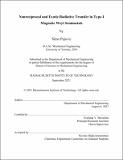| dc.description.abstract | The classical theory of radiative heat transfer has proven extraordinarily useful, both in advancing fundamental physics through the discovery of quantum mechanics and in developing practical applications. However, the classical theory can break down, opening up new opportunities for energy production and management. Kirchhoff’s law of radiation breaks down in systems with broken Lorentz reciprocity, which are characterized by asymmetric dielectric tensors and broken time reversal symmetry. This is typically achieved using an external magnetic field, but a recently discovered family of quantum materials—Weyl semimetals—can possess intrinsic nonreciprocity due to the Berry curvature, an internal, pseudo-magnetic field.
In this dissertation, we explore thermal radiation from type-I magnetic Weyl semimetals in planar configurations in the far- and near-fields. First, we demonstrate that a planar interface between air and a Weyl semimetal can intrinsically violate Kirchhoff’s law of radiation, and that nonreciprocal surface plasmon polaritons (SPPs) excited on this interface drive the nonreciprocity in the radiative heat transfer. In addition, we propose a physical mechanism for the nonreciprocity in terms of the forces felt by electrons as a result of the Berry curvature. Further leveraging the nonreciprocal SPPs, we explore the radiative heat transfer between two planar Weyl semimetal surfaces in the near-field (where Planck’s law also breaks down). To accurately compute the nearfield radiative heat transfer, we include the effects of Fermi arc surface states, a hallmark of Weyl semimetals. We show that—in contrast to far-field radiative heat transfer—Fermi arc surface states play a significant role in the near-field and that the heat flux between the two Weyl semimetals can be tuned via twisting their surfaces in the lateral direction. This twist-controlled heat flux raises questions about the role of the configurational symmetry of the two-body system, and we argue that using materials with asymmetric dielectric tensors is necessary but not sufficient to realize nonreciprocal radiative heat transfer. The system must also possess some broken configurational symmetry, namely inversion symmetry. Finally, we identify opportunities for new discoveries in thermal radiation from materials with broken inversion and time reversal symmetry. | |
